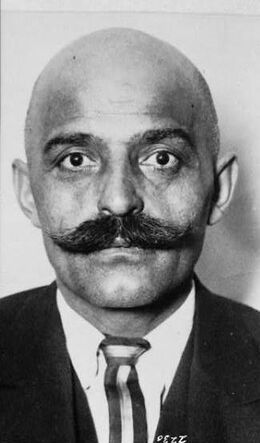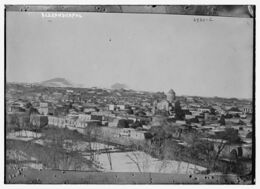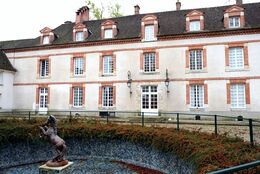Georges Ivanovich Gurdjieff
Georges Ivanovich Gurdjieff was a mystic, philosopher, esoteric writer, spiritual teacher, composer, and choreographer of Armenian and Greek descent. He was born in Alexandropol, Armenia (back then part of the Russian Empire) in the late 19th century, with his birth date often cited as January 13, 1866. He is best known for his teachings on self-awareness and self-improvement, which he referred to as "The Work" or "The Fourth Way." Gurdjieff worked first in Russia and later in France and became known as a teacher and founder of a worldwide and widespread following.
Gurdjieff established the Institute for the Harmonious Development of Manin 1919 at Tiflis (now Tbilisi), Georgia, where he taught his ideas through a combination of lectures, music, dance (Movements), and group work. It was reestablished at Fontainebleau, France, in 1922. [1]
Gurdjieff is known for his charismatic personality and idiosyncratic, improvisatory methods of teaching and his life and teachings have been explored and critiqued in countless publications. [2]
Some of his students called the Gurdjieff approach “A method of Conscious Effort and Voluntary Suffering against INERTIA and REPETITION.” He died on October 29, 1949, in Neuilly-sur-Seine, France. His legacy continues through the work of various Gurdjieff foundations and groups around the world. [3]
Early Life
The very date of Gurdjieff’s birth is in dispute, although he himself stipulates 1866. [4] Between his birth and 1912 biographers have to be reliant on Gurdjieff's own four impressionistic accounts, which are not very consistent. Notoriously problematical are 'the missing twenty years' from 1887 to 1907. [5]
Based on Gurdjieff’s account, he grew up in the volatile Caucasus region located between Christian Orthodox Russia and Islamic Turkey, Iraq, and Persia. His family moved from Alexandropol to Kars shortly after its recapture by Russia from the Turks. There he was tutored by the Dean of the Russian Orthodox Cathedral and later by Bogachevsky, a candidate for the priesthood, who tutored him in the Christian precepts. Gurdjieff revered this teacher all his life.
Coming "to the whole sensation" of himself at an early age and recognizing the mindless mechanicality of human life, the question arose within Gurdjieff—what is the meaning and purpose of life on earth and of human life in particular?[6]
Gurdjieff's search for such knowledge led him to travel widely, seeking out sacred cities and sites through the Middle East and Central Asia in pursuit of esoteric knowledge. The only account of his wanderings appears in his book Meetings with Remarkable Men.[7] He arrived in Moscow in 1912 with the groundwork of his teaching formulated and began gathering pupils. He founded an Institute in 1918, which eventually became the Institute for the Harmonious Development of Man.. It began in Essentuki in the Caucasus, and moved to Tiflis then Constantinople, Berlin, and finally, in October 1922, at the Château Le Prieuré at Fontainebleau-Avon where it functioned until 1932. [8]
Institute for the Harmonious Development of Man
Gurdjieff first established the Institute for the Harmonious Development of Manin 1919 at Tiflis (now Tbilisi), Georgia, where he taught his ideas through a combination of lectures, music, dance (Movements), and group work. [9]
After escaping the Russian revolution with dozens of followers and family members, Gurdjieff settled in France and reestablished the Institute for Harmonious Development of Man at the Château Le Prieuré at Fontainebleau-Avon in October of 1922.
Gurdjieff was of the opinion that modern man's world perception and his own mode of living are not the conscious expression of his being taken as a complete whole. Quite on the contrary, they are only the unconscious manifestation of one or another part of him.
Thus, members living at the institute, many from prominent backgrounds, lived a virtually monastic life, except for a few banquets, at which Gurdjieff would engage in probing dialogue and at which his writings were read. Ritual exercises and dance were also part of the regimen, often accompanied by music composed jointly by Gurdjieff and an associate, the composer Thomas de Hartmann. Performers from the institute appeared in Paris in 1923 and in three U.S. cities the following year and brought considerable attention to Gurdjieff’s work. [10]
Gurdjieff’s Work and Ideas
The Fourth Way
Gurdjieff's Fourth Way is a spiritual teaching that combines elements of Eastern and Western philosophy and religion. It is called the Fourth Way because it is said to be a path that integrates the three traditional ways of spiritual development:
the way of the fakir (physical discipline), the way of the monk (emotional devotion), and the way of the yogi (mental concentration).
The Fourth Way emphasizes the development of consciousness and self-awareness while living an ordinary life in the world, rather than through withdrawal from the world as in monastic or ascetic practices. Gurdjieff believed that most people live their lives in a state of "waking sleep," and that true spiritual awakening requires conscious effort and work on oneself.
Key concepts of the Fourth Way include:
1. Self-observation: Paying attention to one's thoughts, emotions, and actions in the present moment without judgment or identification. Gurdjieff also called this “conscious suffering”. 2. Self-remembering: A practice of maintaining awareness of oneself and one's surroundings simultaneously, to be present and not lost in identification with thoughts or emotions. 3. The Enneagram: A geometric symbol used as a tool for understanding the dynamics of personality and the processes of transformation. 4. Three Centers: The idea that humans have three centers of functioning - intellectual, emotional, and physical - and that balanced development of these centers is essential for spiritual growth. 5. Identification and Non-identification: Learning to detach from identifying with one's thoughts, emotions, and roles in life. 6. Internal and External Considering: Balancing one's own needs and interests with those of others in interactions.
Gurdjieff's teachings were not systematic and were often transmitted orally through direct work with his students. He used various methods, including group work, music, dance (Movements), and practical tasks, to help students develop self-awareness and inner growth.
The Fourth Way has influenced various spiritual and self-development movements and continues to be studied and practiced by groups around the world. [11] [12][13][14][15]
Notes
- ↑ Britannica. George Ivanovitch Gurdjieff. https://www.britannica.com/biography/George-Ivanovitch-Gurdjieff. Accessed on 3/9/24
- ↑ Petsche, Johanna.A Gurdjieff Genealogy: Tracing the manifold Ways the Gurdjieff Teaching has travelled.International Journal for the Study of New Religions, Vol. 4, No. 1, 2013
- ↑ Anderson, Margaret. The Unknowable Gurdjieff. Penguin Books Ltd., London, England. 1962
- ↑ Ginsburg, B. Seymor. Gurdjieff Unveiled: AN OVERVIEW AND INTRODUCTION TO GURDJIEFF'S TEACHING. Lighthouse Editions LTD; First Edition (January 1, 2005). Lesson1
- ↑ Moore, James. Gurdjieff Chronology. https://www.gurdjieff.org/chronology.htm Accessed on 3/12/24
- ↑ Gurdjieff’s Early Years.THE GURDJIEFF LEGACY FOUNDATION: The Teaching for our Time. https://gurdjiefflegacy.org/70links/early_years.htm Accessed on 3/18/24
- ↑ Owens, Terry Winter.All and Everything – Meetings with Remarkable Men. Gurdjieff International Review. https://www.gurdjieff.org/owens2.htm. Accessed on 4/2/24
- ↑ Petsche, Johanna. A Gurdjieff Genealogy: Tracing the Manifold Ways the Gurdjieff Teaching Has Travelled. In: International Journal for the Study of New Religions, Vol. 4, No. 2013.
- ↑ Britannica. George Ivanovitch Gurdjieff. https://www.britannica.com/biography/George-Ivanovitch-Gurdjieff. Accessed on 3/9/24
- ↑ Britannica. George Ivanovitch Gurdjieff. https://www.britannica.com/biography/George-Ivanovitch-Gurdjieff. Accessed on 3/2/24
- ↑ Ouspensky, P.D. The Fourth WayVintage; New edition, February 12, 1971.
- ↑ Ginsburg, B. Seymor. Gurdjieff Unveiled: AN OVERVIEW AND INTRODUCTION TO GURDJIEFF'S TEACHING. Lighthouse Editions LTD; First Edition (January 1, 2005). Lesson1
- ↑ Azize, Joseph et al. Mysticism, Contemplation, and Exercises. Oxford Academic Books. 2 An Overview of Gurdjieff’s Ideas. December 2019
- ↑ de Salzmann, Jeanne. THE REALITY OF BEING: The Fourth Way of Gurdjieff.Shambhala, Boston & London, 2011
- ↑ Anderson, Margaret. The Unknowable Gurdjieff. Penguin Books Ltd., London, England. 1962



